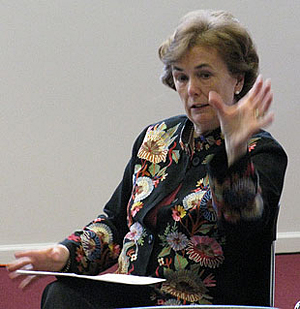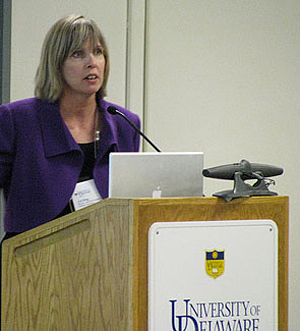ADVERTISEMENT
- Rozovsky wins prestigious NSF Early Career Award
- UD students meet alumni, experience 'closing bell' at NYSE
- Newark Police seek assistance in identifying suspects in robbery
- Rivlin says bipartisan budget action, stronger budget rules key to reversing debt
- Stink bugs shouldn't pose problem until late summer
- Gao to honor Placido Domingo in Washington performance
- Adopt-A-Highway project keeps Lewes road clean
- WVUD's Radiothon fundraiser runs April 1-10
- W.D. Snodgrass Symposium to honor Pulitzer winner
- New guide helps cancer patients manage symptoms
- UD in the News, March 25, 2011
- For the Record, March 25, 2011
- Public opinion expert discusses world views of U.S. in Global Agenda series
- Congressional delegation, dean laud Center for Community Research and Service program
- Center for Political Communication sets symposium on politics, entertainment
- Students work to raise funds, awareness of domestic violence
- Equestrian team wins regional championship in Western riding
- Markell, Harker stress importance of agriculture to Delaware's economy
- Carol A. Ammon MBA Case Competition winners announced
- Prof presents blood-clotting studies at Gordon Research Conference
- Sexual Assault Awareness Month events, programs announced
- Stay connected with Sea Grant, CEOE e-newsletter
- A message to UD regarding the tragedy in Japan
- More News >>
- March 31-May 14: REP stages Neil Simon's 'The Good Doctor'
- April 2: Newark plans annual 'wine and dine'
- April 5: Expert perspective on U.S. health care
- April 5: Comedian Ace Guillen to visit Scrounge
- April 6, May 4: School of Nursing sponsors research lecture series
- April 6-May 4: Confucius Institute presents Chinese Film Series on Wednesdays
- April 6: IPCC's Pachauri to discuss sustainable development in DENIN Dialogue Series
- April 7: 'WVUDstock' radiothon concert announced
- April 8: English Language Institute presents 'Arts in Translation'
- April 9: Green and Healthy Living Expo planned at The Bob
- April 9: Center for Political Communication to host Onion editor
- April 10: Alumni Easter Egg-stravaganza planned
- April 11: CDS session to focus on visual assistive technologies
- April 12: T.J. Stiles to speak at UDLA annual dinner
- April 15, 16: Annual UD push lawnmower tune-up scheduled
- April 15, 16: Master Players series presents iMusic 4, China Magpie
- April 15, 16: Delaware Symphony, UD chorus to perform Mahler work
- April 18: Former NFL Coach Bill Cowher featured in UD Speaks
- April 21-24: Sesame Street Live brings Elmo and friends to The Bob
- April 30: Save the date for Ag Day 2011 at UD
- April 30: Symposium to consider 'Frontiers at the Chemistry-Biology Interface'
- April 30-May 1: Relay for Life set at Delaware Field House
- May 4: Delaware Membrane Protein Symposium announced
- May 5: Northwestern University's Leon Keer to deliver Kerr lecture
- May 7: Women's volleyball team to host second annual Spring Fling
- Through May 3: SPPA announces speakers for 10th annual lecture series
- Through May 4: Global Agenda sees U.S. through others' eyes; World Bank president to speak
- Through May 4: 'Research on Race, Ethnicity, Culture' topic of series
- Through May 9: Black American Studies announces lecture series
- Through May 11: 'Challenges in Jewish Culture' lecture series announced
- Through May 11: Area Studies research featured in speaker series
- Through June 5: 'Andy Warhol: Behind the Camera' on view in Old College Gallery
- Through July 15: 'Bodyscapes' on view at Mechanical Hall Gallery
- More What's Happening >>
- UD calendar >>
- Middle States evaluation team on campus April 5
- Phipps named HR Liaison of the Quarter
- Senior wins iPad for participating in assessment study
- April 19: Procurement Services schedules information sessions
- UD Bookstore announces spring break hours
- HealthyU Wellness Program encourages employees to 'Step into Spring'
- April 8-29: Faculty roundtable series considers student engagement
- GRE is changing; learn more at April 15 info session
- April 30: UD Evening with Blue Rocks set for employees
- Morris Library to be open 24/7 during final exams
- More Campus FYI >>
1:49 p.m., Jan. 12, 2010----University of Delaware Provost Tom Apple welcomed more than 80 participants to the kick-off event of the Winter Faculty Institute on Jan. 5.
“UD's Path to Prominence begins with the excellence of our faculty, which includes professional development such as today's. I'm thrilled to see this turnout -- it is heartening to see the dedication of our faculty,” Apple said.
Faculty and others joined colleagues to learn about course redesign and e-portfolios at the opening day of the month-long teaching and technology institute. After morning presentations, participants were invited to join their peers at hands-on workshops, which focused on the morning's topics.
Improving student learning while reducing instructional costs: The case for redesign
“Course redesign is the process of redesigning whole courses rather than individual classes or sections to achieve better learning outcomes at a lower cost by taking advantage of the capabilities of information technology,” Carolyn Jarmon, senior associate for the National Center for Academic Transformation (NCAT), said.
Jarmon has worked with more than 100 institutions across the United States to redesign courses. The examples she discussed validate that colleges and universities can use information technology to achieve the dual goals of improving student learning while reducing instructional costs.
“However,” Jarmon said, “just using technology is not the goal; increasing learning and retention is the goal.”
As technology has matured, educational institutions have tried various technologies to help their institutions enhance learning. Because the traditional technique of “live” classroom lectures is not always the best option, colleges and universities began offering “bolt-on” (online) lectures.
“While the 'bolt-on' technique increased the number of students who could be reached, it did not change the basic form of teaching,” Jarmon said.
“Next, classes were made smaller by offering multiple sections. Although the groups were smaller, multiple sections don't ensure that the educational technique is the same across sections,” she added.
Using a combination of older and newer technology, was it possible to increase learning -- and decrease costs -- even though established literature said it wasn't possible?
“We have a responsibility to provide the best education possible,” Jarmon said, “which led us to evaluate the benefits of comprehensive course redesign.”
According to Jarmon, the most common reasons institutions explore course redesign are high student withdrawal or failure rates, long waiting lists, unavailable classes causing a graduation bottleneck, over-enrollment of courses leading to multiple majors, inconsistency in student preparation, difficulty hiring qualified adjuncts and inadequate student preparation in subsequent courses.
Jarmon discussed briefly seven models of course redesign. Although each model is different, every successful model applied the following elements:
- Redesigning the whole course -- not just a single class;
- Emphasizing active learning -- greater student engagement with the material and with one another;
- Relying on readily available interactive software -- used independently and in teams;
- Demanding mastery learning -- not self-paced;
- Increasing on-demand, individualized assistance;
- Automating components that can benefit from this process (e.g., homework, quizzes, exams, etc.); and
- Supplanting single mode instruction with differentiated personnel where appropriate (e.g., undergraduate and graduate students, adjuncts, etc.).
For faculty, benefits include working directly with students who need help, reducing the amount of grading, using technology to do tracking and monitoring, increasing practice time and interaction between students without faculty effort, facilitating different approaches to meet different student needs and enabling continuous improvement of materials and approaches.
“In spite of what the existing literature said, as these examples illustrate, comprehensive course redesign does lead to improved learning and retention for students, benefits for faculty and significant decreased costs for the institution,” Jarmon said.
E-portfolios: Planning for successful and efficient implementation
“Over the past few years, Clemson has made some changes: All students now have laptops, the university has a new set of core competencies and every student is now required to submit an e-portfolio to graduate,” Gail Ring, director of the e-portfolio program at Clemson University, said.
Ring discussed Clemson's e-portfolio program in which all 14,713 undergraduate students, including transfer students, were required to submit an e-portfolio to demonstrate their skills and abilities toward achieving the university's new core competencies.
“The purpose of the e-portfolio program was as a mechanism to evaluate core competencies, an opportunity for students to reflect on learning and a way to add value to a Clemson degree,” Ring said.
One of the goals of the project was to “shift the locus of control from the teacher to the student -- it helps students connect their academic selves with their professional selves,” Ring said.
“For many students, critical thinking was a challenge. The students didn't know how to explain what they've learned or how they've learned it. Some students had difficulty getting what was in their head into their e-portfolio,” she said.
Ring said, “It was helpful to tell students to 'think about yourself as an engineer or a biologist' because that's what you are.”
Student reflection improves a student's ability to attach meaning to an experience, share experiences, look at the big picture and makes learning visible, she said, adding, “What we're striving for is better answers to the questions: What have you learned here at Clemson and how can you articulate what you've learned?”
“The project is now a student driven initiative,” Ring said. A campus facility called “Studio 1941” is a gathering place for students to share ideas and help one another with their e-portfolios. Undergraduate students staff the studio and help one another judge what they need to do for their e-portfolios. Tutorials and workshops are also available to students.
The program also offers peer mentors who provide feedback. These peer mentors have been through rigorous training and advise other students how to improve their e-portfolios.
“Every artifact students choose to include in their e-portfolio must have a rational statement attached to it,” Ring said. “One of the tasks of the peer mentors is to help students understand and articulate the rationale behind including a certain artifact,” she said.
Besides the personal and academic benefits of the e-portfolios, a professional benefit is unmistakable: More than 70 percent of employers polled (companies near Clemson) said they would look at an e-portfolio for employment purposes.
“We currently have two type of assessment for core competency,” Ring said. These assessments evaluate how well the students use critical thinking to articulate what they know using the e-portfolio.
“Students use Google Sites for their e-portfolio,” Ring said. Originally, the campus used other tools, but the tool must provide built-in flexibility. “Google Sites provided the flexibility we needed,” she said.
“The lessons we learned from this project are that student and faculty ownership is essential, flexibility and reflection must be built into the system and change takes time,” she said.
Ring added, “One of our most interesting success stories is an education major named Jenna who was a self-professed e-portfolio rebel. Initially, she rejected the benefits of the program. She is now a poster child for e-portfolios: Her e-portfolio clearly demonstrates who she is as a learner, who she is as an educator and how she fits into the big picture within Clemson.”
To access recordings of the presentations, presentation slides and other archived information from the day, visit the Winter Faculty Institute Web site.
To register for Institute classes offered throughout the month, visit the IT Learning Resources Web site.
The Winter Faculty Institute is coordinated by Information Technologies and the Center for Educational Effectiveness and is co-sponsored by the University of Delaware Library, Institute for Transforming Undergraduate Education, UD Online, Office of Service Learning, Office of Educational Technology, and Undergraduate Research.




